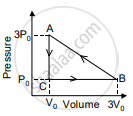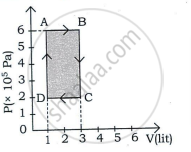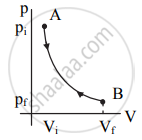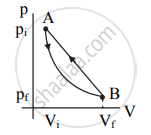Advertisements
Advertisements
Question
Differentiate between the reversible and irreversible processes.
Solution
| Sr. No. | Reversible process | Irreversible process |
| i. | A reversible process is a change that can be retraced in a reverse (opposite) direction. | An irreversible process is a change that cannot be retraced in a reverse (opposite) direction. |
| ii. | The path of a reversible process is the same in the forward and the reverse direction. | The path of an irreversible process is not the same in the forward and the reverse direction. |
| iii. | Reversible changes are very slow and there is no loss of any energy in the process. | There is a permanent loss of energy from the system due to friction or other dissipative forces in an irreversible process. |
| iv. | The system comes back to its initial state after it is taken along the reverse path. | The change of state depends upon the path taken to change the state during an irreversible process. |
| v. | Reversible processes are ideal processes. | Irreversible processes are real processes. |
| vi. |
p-V diagram:
|
p-V diagram:
|
RELATED QUESTIONS
A thermodynamic system is taken from an original state to an intermediate state by the linear process shown in Figure

Its volume is then reduced to the original value from E to F by an isobaric process. Calculate the total work done by the gas from D to E to F
Give an example of some familiar process in which heat is added to an object, without changing its temperature.
An ideal gas is taken through an isothermal process. If it does 2000 J of work on its environment, how much heat is added to it?
For work done to be reversible, the process should be ______
Draw a p-V diagram showing negative work with varying pressure.
State the assumptions made for thermodynamic processes.
3 mole of a gas at temperature 400 K expands isothermally from an initial volume of 4 litres to a final volume of 8 litres. Find the work done by the gas. (R = 8.31 J mol-1 K-1)
Write a note on free expansion.
Explain the thermodynamics of the isochoric process.
Explain thermodynamics of the adiabatic process.
When a cycle tyre suddenly bursts, the air inside the tyre expands. This process is ____________.
When food is cooked in a vessel by keeping the lid closed, after some time the steam pushes the lid outward. By considering the steam as a thermodynamic system, then in the cooking process
Apply first law for an adiabatic process.
Draw the PV diagram for the isothermal process.
Draw the PV diagram for the isobaric process.
What is a cyclic process?
Explain in detail an adiabatic process.
What are the limitations of the first law of thermodynamics?
A thermodynamic system undergoes cyclic process ABCDA as shown in the figure. The work done by the system is ______

An ideal gas is expanded isothermally from volume V1 to volume V2 and then compressed adiabatically to original volume V1. If the initial pressure is P1, the final pressure is P3 and net work done is W, then ____________.
In which of the following processes, beat is neither absorbed nor released by a system?
An ideal gas A and a real gas B have their volumes increased from V to 2V under isothermal conditions. The increase in internal energy ____________.
Ideal gas for which 'ϒ' = 1.5 is suddenly compressed to `1/4`th of its initial volume. The ratio of 4 the final pressure to the initial pressure is ______.
`(ϒ = "C"_"p"/"C"_"v")`
The work done on the system in changing the state of a gas adiabatically from equilibrium state A to equilibrium state B is 22.4 J. If the gas is taken from state A to B through another process in which the net heat absorbed by the system is 15.5 cal, then the net work done by the system in the latter case is ______.
( l cal = 4.2 J)
In the figure shown here, the work done in the process ACBA is ______.

Explain the thermodynamic process.
When an inflated ballon is suddenly burst, why is the emerging air slightly cooled?
An ideal gas is taken through a cyclic process ABCDA as shown in figure. The net work done by the gas during the cycle is ______.



